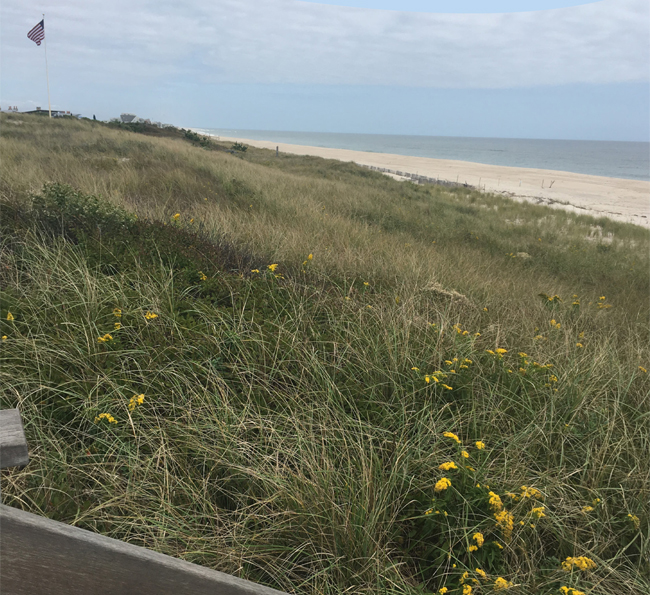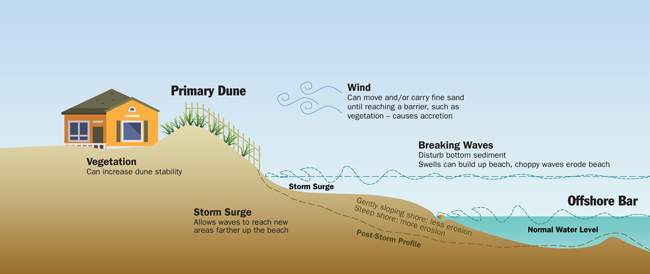
A healthy dune system is stabilized by plant roots and works to protect against coastal storm’s damaging wave energy and surge.
Contact:
Kathleen Fallon, New York Sea Grant's Coastal Processes & Hazards Specialist, P: 631-632-8730, E: kmf228@cornell.edu
Stony Brook, NY, April 18, 2022 - After Superstorm Sandy rumbled through Long Island in 2012, East Atlantic Beach — a hamlet of a south shore barrier island in Nassau County — did not experience as much destruction as their neighbors from the wrath of the storm. The difference between the two areas? Dunes. East Atlantic Beach has dunes protecting their infrastructure while other communities like Long Beach lacked dunes with their open low-lying beaches.
Healthy dune systems play an important role in resiliency during storms. Dunes may not look like much, but there is a whole system and cycle at work. Ocean currents in the nearshore carry sediment to, from, and along the beaches. The sand that is deposited on shore will dry and can be carried by the wind towards the landward side of the beach. This sand accumulates to form the dunes. American Beach Grass that grows within the dunes has substantial root systems that stabilize and further build the dunes by capturing more wind-blown sediment. Have you ever noticed fencing installed in and around the dunes? This fencing, similar to the grass, also acts as a sand collector, further building the dunes. As a result, dunes protect our shorelines and become our first line of defense against strong wave energy and storm surges, especially during damaging storm events. Because of this, dunes can help protect inland communities and their assets. While the dunes may take the brunt of the storm, they act as a sand replenisher for the beach and the dune building cycle will start again.
It is important to increase understanding of how dunes work and the value they provide for beach communities. Especially in the face of climate change, with more frequent and intense storm events expected to occur. Unfortunately, there are instances where beachgoers may walk or climb through dunes. This causes destabilization and diminishes the protection power that dunes offer for our beach communities.
With concern for the dunes and the interest to keep them healthy, the East Atlantic Beach Conservation Committee reached out to New York Sea Grant (NYSG) for help. NYSG developed an informative “Healthy Dune Systems” brochure (pdf) to help educate people about the value of these nature made structures and the science behind them. East Atlantic Beach received 750 copies of this brochure to further inform and encourage beachgoers to use designated dune cross-over paths.

Causes of erosion and deposition on a beach. Illustration Credit: Loriann Cody.
“The Sea Grant brochure is an important piece in educating our community on how the dunes are formed, their continual maintenance, and the importance of protection against storm surges. It highlights how fragile the dunes are and the necessity of their protection,” says John Grasser, President of the East Atlantic Beach Conservation Committee (EABCC). “The feedback we received from the community was very positive and appreciative. It is a great starting point for understanding our coastal ecosystem.”
NYSG is providing general access to the “Healthy Dune Systems” brochure for people to view and share with their networks. This is a great resource for beach communities to use, not only for their beach-side residents but also for tourists and beach visitors that come from afar. Education is key to protecting the dunes and the assets they protect.
“Dune education is important for all south shore communities here on Long Island. I hope this brochure is used widely as a tool to help educate folks about the value of dunes and how to do your part to protect them,” says Kathleen Fallon, Coastal Processes and Hazards Specialist, New York Sea Grant.
Please contact Kathleen Fallon at kmf228@cornell.edu if you are interested in receiving printed copies of the brochure.
More Info: New York Sea Grant
New York Sea Grant (NYSG), a cooperative program of Cornell University and the State University of New York (SUNY), is one of 34 university-based programs under the National Oceanic and Atmospheric Administration’s National Sea Grant College Program.
Since 1971, NYSG has represented a statewide network of integrated research, education and extension services promoting coastal community economic vitality, environmental sustainability and citizen awareness and understanding about the State’s marine and Great Lakes resources.
Through NYSG’s efforts, the combined talents of university scientists and extension specialists help develop and transfer science-based information to many coastal user groups—businesses and industries, federal, state and local government decision-makers and agency managers, educators, the media and the interested public.
The program maintains Great Lakes offices at Cornell University, University at Buffalo, SUNY Oswego and the Wayne County Cooperative Extension office in Newark. In the State's marine waters, NYSG has offices at Stony Brook University and Cornell Cooperative Extension of Nassau County on Long Island; at Brooklyn College, with New York City Department of Environmental Protection in Queens and at Cornell Cooperative Extension in NYC and Elmsford and Kingston in the Hudson Valley.
For updates on Sea Grant activities: www.nyseagrant.org has RSS, Facebook, Twitter, Instagram, and YouTube links. NYSG offers a free e-list sign up via www.nyseagrant.org/nycoastlines for its flagship publication, NY Coastlines/Currents, which is published quarterly.